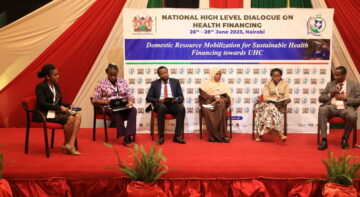Blogs

The World Health Organization’s (WHO) latest guideline on when to start antiretroviral therapy (ART) among people living with HIV and on pre-exposure prophylaxis (PrEP) for HIV is good news and a step closer towards closing the tap of the HIV epidemic.
The guideline recommends the initiation of ART in adults living with HIV, regardless of CD4 cell count, and offering of PrEP as a prevention option to all people at increased risk of acquiring HIV.
Implementation of this new guideline means abandoning the partial or piecemeal use of antiretroviral medicines in favour of full access for all people living with HIV.
Both science and conscience demand that these recommendations be put into effect as quickly as possible. With such bold recommendations, there is the potential to not only simplify ART access among people living with HIV but also significantly alter how HIV prevention among the most at risk populations will be approached.
Indeed, this is a great moment to celebrate for all proponents of using ART for HIV prevention (treatment as prevention). This guideline is expected and looked at by many as the magic bullet and the beginning of the end for the HIV epidemic.
Although it is not yet clear how countries will embrace this new guidance, evidence suggests that ART for people living with HIV leads to suppression of the virus and thus reduces the chances of transmitting the virus.
Efforts must now be consolidated in trying to ensure that these guidelines find their way in the national HIV strategic plans for implementation in order to rip the benefits the guide promises.
It is very important therefore that these new guidelines are operationalised as soon as possible if we are to achieve the UNAIDS target of zero new HIV infections by 2030.
Indeed UNAIDS estimates, expanding ART to all people living with HIV and expanding prevention choices can help avert 21 million AIDS-related deaths and 28 million new infections by 2030.
Implementing these guidelines will require funds and serious logistical planning to ensure that every person living with HIV for instance can access these drugs.
In the Kenyan set up, pre-exposure prophylaxis (using of ARV to prevent HIV infection) will be a novel idea to many and therefore, will require awareness creation to ensure people understand how it works.
The scenario may be made more complex by the existing stigma towards HIV infected persons and the culture of persons seeking healthcare only when they “feel sick’.
To succeed, like any other health programme, there will be need to have in place good system that will enable collection, storage and analysis of programme data to inform programme improvements.
WHO recognises that “implementation of the guideline needs to be accompanied by efforts to promote and protect the human rights of people in need of HIV services, including by ensuring informed consent, preventing stigma and discrimination in the provision of services and promoting gender equity.”
This will be particularly music to the ears of the key and vulnerable populations who are at a higher risk of HIV acquisition but, who have for a long time, been marginalised in the access and utilisation of HIV prevention, care and treatment services.
Indeed, WHO estimates that if implemented, the test and treat would see a 35 percent increment in the number of people living with HIV eligible for treatment.
The only bottle neck envisaged by WHO in the operationalisation and implementation of the guideline is the knowledge gap in the provision of ART on testing which previously has been based on the levels of CD4 cells which the health body notes still has an important role to play in many other contexts.
Pre-Exposure Prophylaxis, PrEP
In the new guidelines, WHO has recommended PrEP for all individuals at substantial risk of acquiring HIV expanding on its previous guides that only recommended PrEP or discordant couples and men who have sex with men.
Substantial risk has been defined by WHO to mean living in a community whose number of new HIV infection cases per year is 3 percent or more.
Examples of people at substantial risk include men who have sex with men, discordant couples, sex workers, prisoners and adolescent girls.
These groups have indeed sometimes been referred to as key population or vulnerable population or most at risk populations in the fight against HIV.
This guidance on PrEP indeed is a welcome development creating a window of opportunity to provide PrEP to all other key and vulnerable populations including young women and adolescents.
One can only hope that this will lay ground for even more HIV preventive approaches such as vaginal rings currently being investigated finally getting adopted for HIV prevention.
Related Posts





